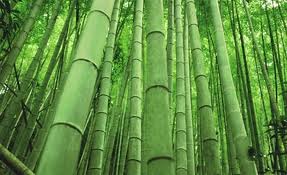 Hardwood flooring has been all the rage with homeowners in recent years. Hardwood floors can increase the value of your home tremendously, are easy to take care of and can be installed by you or a professional. Wood floors are also great for people with allergies. Unlike carpet, which traps dust mites and other allergens, wood can be easily swept and cleaned. The wide variety of woods available makes it a great flooring choice for any budget.
Hardwood flooring has been all the rage with homeowners in recent years. Hardwood floors can increase the value of your home tremendously, are easy to take care of and can be installed by you or a professional. Wood floors are also great for people with allergies. Unlike carpet, which traps dust mites and other allergens, wood can be easily swept and cleaned. The wide variety of woods available makes it a great flooring choice for any budget.
In the age of green building, bamboo flooring has become a major player in hardwood options. An incredibly durable, versatile, sustainable and price-competitive form of hardwood flooring, bamboo has become the floor of choice for many people building or renovating homes with an eco-friendly edge. In fact, what makes bamboo so unique and appealing as a flooring option is its sustainability. Bamboo is considered a rapidly renewable source of wood. When it’s cut, the root of the bamboo stalk stays in the ground. It grows back to a mature height in anywhere from three and a half to seven years. Then, it’s ready to be cut again. That’s incredibly fast, considering a tree such as an oak can take more than 120 years to be strong enough to be harvested for wood!
Bamboo floors are also very popular because they give a stunning look to any room and can be adapted to any decorating style. Bamboo itself can also be dyed into many colors or kept completely natural, finished or unfinished. The choices are almost infinite. You can also find bamboo at reasonable prices, which makes it a wonderful option for redecorating on a budget.
What is Bamboo?
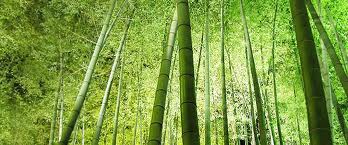 Bamboo is a group of perennial evergreens in the true grass family Poaceae, subfamily Bambusoideae, tribe Bambuseae. Giant bamboos are the largest members of the grass family. In bamboo, the internodal regions of the stem are hollow and the vascular bundles in the cross section are scattered throughout the stem instead of in a cylindrical arrangement.
Bamboo is a group of perennial evergreens in the true grass family Poaceae, subfamily Bambusoideae, tribe Bambuseae. Giant bamboos are the largest members of the grass family. In bamboo, the internodal regions of the stem are hollow and the vascular bundles in the cross section are scattered throughout the stem instead of in a cylindrical arrangement.
Bamboos are some of the fastest growing plants in the world, as some species have been recorded as growing up to 100 cm (39 inches) within a 24 hour period due to a unique rhizome-dependent system. Bamboos are of notable economic and cultural significance in South Asia, South East Asia and East Asia, being used for building materials, as a food source, and as a versatile raw product.
Source: http://en.wikipedia.org/wiki/Bamboo
Bamboo Flooring Design
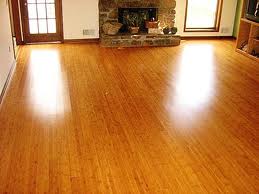 When trees are cut down, the stump and roots are left in the ground to die. However, when bamboo is properly harvested, the root system remains intact, allowing the bamboo to grow again to its full size. Bamboo is usually harvested when the stalks are around six years old. If bamboo is harvested earlier, it won’t produce a strong floor. Harvested later, the bamboo will be too brittle. Since it’s hollow, there’s very little waste produced when making the flooring. Every part of the Bamboo is used in the process, making a very sustainable flooring product.
When trees are cut down, the stump and roots are left in the ground to die. However, when bamboo is properly harvested, the root system remains intact, allowing the bamboo to grow again to its full size. Bamboo is usually harvested when the stalks are around six years old. If bamboo is harvested earlier, it won’t produce a strong floor. Harvested later, the bamboo will be too brittle. Since it’s hollow, there’s very little waste produced when making the flooring. Every part of the Bamboo is used in the process, making a very sustainable flooring product.
In the first part of the production process, the exterior, green layer and shoots of the bamboo stalk are removed. Then, the stalks are cut into strips called logs, resembling the length of the final flooring products. The bamboo then goes through a purification process, usually by boiling it to remove any insects or sugars that may be left in the bamboo. Some bamboo is steamed under pressure to give it a darker color, discussed below.
Next, the bamboo logs are sorted into “A” and “B” grades based on quality. After they’re separated, the strips are dried in a kiln. Then, the strips are assembled either horizontally or vertically, glued together and pressed under high pressure to achieve the strength and durability that makes bamboo flooring so popular.
The final step is milling the bamboo planks (what bamboo boards are called after they’re formed and glued). Milling creates the finish of the flooring. At this step, the planks are shaped into perfectly measured boards with smooth edges so they can be properly installed. In this part of the process, cuts called grooves are created in the planks for click-on flooring, which we’ll discuss later.
Now, here’s how we get so many colors of bamboo flooring. After the bamboo stalks are cut into strips, manufacturers can choose to keep the strips a natural color, or follow a carbonization process to darken the wood.
Natural bamboo – After the harvesting and stripping processes, bamboo strips are boiled to eliminate impurities. The natural color of the bamboo emerges. It’s a light — almost blond — wood color. This is considered to be the “natural” bamboo color, and further color processing is not necessary. The boards are then glued and pressed together into bamboo planks.
Carbonized bamboo – To carbonize bamboo, bamboo strips are immediately pressure-steamed after stripping to give the bamboo a darker color. Carbon is added to the steam chamber, which dyes the bamboo throughout the strips, not just on the surface. Carbonized bamboo ranges in color from a honey or caramel color to a light coffee. Carbonizing actually decreases the floor’s strength about eight to ten percent, so keep that in mind when researching bamboo flooring.
Stained bamboo – Bamboo planks can also be stained into a wide spectrum of colors after the bamboo planks have been produced. Bamboo distributors can dye the wood virtually any color of the rainbow to accompany any interior design style. Stain can be painted on or rubbed on by hand.
Bamboo can be processed into boards in a variety of styles and colors. The surfaces can also be finished or left unfinished. There are an infinite number of options to consider when choosing bamboo flooring. First, let’s take a closer look at bamboo flooring construction.
Bamboo Isn’t Just For Pandas Anymore
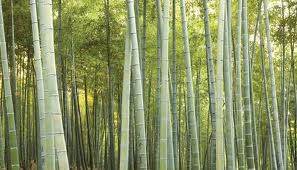 Bamboo isn’t just the darling of the flooring industry. This versatile grass can also be processed into such useful items as window shades, bed linens, towels, furniture, cutting boards, cabinetry, floor mats, paper, chopsticks and toys. It can even be blended with cotton for T-shirts.
Bamboo isn’t just the darling of the flooring industry. This versatile grass can also be processed into such useful items as window shades, bed linens, towels, furniture, cutting boards, cabinetry, floor mats, paper, chopsticks and toys. It can even be blended with cotton for T-shirts.
Solid and Engineered Bamboo Flooring
 During the gluing process of production, solid bamboo flooring can be laminated into three unique styles, each producing a unique look. Choosing which kind of construction is based on decorative choice, but there are strength and environmental aspects for each variety as well. Urea formaldehyde, a chemical that is toxic and does not meet indoor air quality guidelines, is often used as the adhesive during this step. Many companies, however, now use low-emission formaldehyde or a water-based solvent during manufacturing.
During the gluing process of production, solid bamboo flooring can be laminated into three unique styles, each producing a unique look. Choosing which kind of construction is based on decorative choice, but there are strength and environmental aspects for each variety as well. Urea formaldehyde, a chemical that is toxic and does not meet indoor air quality guidelines, is often used as the adhesive during this step. Many companies, however, now use low-emission formaldehyde or a water-based solvent during manufacturing.
With horizontal construction, bamboo strips are placed into three layers on top of one another. One board usually contains 15 strips of bamboo. The strips are then pressed together. This creates a traditional “knuckles” or nodes look, because the grain of the board closely resembles the look of bamboo grass.
With vertical construction, bamboo strips are turned on their side, then laid next to one another. They are then glued and pressed together. Typically, 19 strips of bamboo comprise one vertical bamboo board. Vertical boards give a much more linear look and are considered less durable than the layered, horizontal construction.
Woven, strand-woven or stranded bamboo construction, as it’s sometimes called, differs dramatically from both horizontal and vertical construction. Instead of gluing strips of bamboo together in a uniform way, strands of bamboo fibers are compressed under intense pressure to form the floorboards. The woven look of bamboo flooring is very nontraditional. Manufacturers can create very exotic looking flooring, blending varying colors and length of bamboo strips. Woven construction is also the most environmentally friendly form of bamboo flooring because it uses very little adhesive. It’s also considered to be the most durable of all the bamboo flooring due to the intense pressure used to create it.
One aspect buyers may not realize they need to decide is if the flooring is solid or engineered. While the look of these two kinds of bamboo flooring is similar, there are some differences regarding the strength of bamboo flooring.
Solid bamboo flooring consists of only bamboo strips pressed together to create the floorboards. While more of a pure floor, solid bamboo can only be nailed or glued on the subfloor.
Engineered bamboo flooring consists of bamboo strips (usually 1/8”) on top of the plank, and is layered with other types of wood underneath. Engineered bamboo is thought to be stronger than solid bamboo because of the blending of woods. It can be nailed, glued, or floated to the subfloors.
What is this subfloor we’re talking about and why is it important? Let’s discuss installing bamboo flooring, and the various ways bamboo flooring can help make your home beautiful.
Installing Bamboo Flooring
 Before installing bamboo floors, you must acclimate the boards in the room of choice. Acclimating flooring simply means leaving the boards in the room for several days to get used to the climate of the room. This helps ensure that changes in room temperature and humidity won’t warp the boards after they’re installed. Bamboo flooring can be installed over many types of subfloors, such as wood, plywood, vinyl or concrete. Different types of bamboo flooring can be installed on various subfloors.
Before installing bamboo floors, you must acclimate the boards in the room of choice. Acclimating flooring simply means leaving the boards in the room for several days to get used to the climate of the room. This helps ensure that changes in room temperature and humidity won’t warp the boards after they’re installed. Bamboo flooring can be installed over many types of subfloors, such as wood, plywood, vinyl or concrete. Different types of bamboo flooring can be installed on various subfloors.
Basically, there are three ways to install bamboo flooring. You should consider what type of subfloor surface you’ll be attaching the bamboo boards to and whether you’ll be doing the job yourself or hiring a professional installer.
- Bamboo boards are nailed onto the subfloor with nails or staples. Any type of bamboo flooring can be installed through nailing, which seems to be the preferred method for wood subfloors.
- Flooring is glued directly to the subfloor. Any style of bamboo flooring can be glued. Make sure to use the highest quality glue, and never use water-based glue.
- Floating, click-on or snap-lock flooring is the perfect option for do-it-yourselfers. There is no nailing or gluing involved, meaning less mess with the same results. The bamboo planks are fitted during milling with cuts and grooves that click into one another and lie flat on the subfloor. Not all types of bamboo floors can be floated — engineered floors are the most popular floated floors. If you’re going to tackle this job yourself, follow all instructions carefully. For example, when you install floating flooring, you have to leave enough expansion room, or you’ll end up with buckling and other problems.
To get beautiful floors that last for years, it’s very important to install your bamboo floors properly. Next, let’s find out what it takes to keep your bamboo floor looking new for years to come.
Bamboo Flooring Care
 As with any hardwood floor, there are important factors necessary to keep bamboo looking as beautiful as the day of installation. Most important, make sure to keep water from collecting on floors, which can cause warping. Clean up spills quickly and thoroughly. Areas such as the floor under an icemaker or sink should have a small rug to absorb water.
As with any hardwood floor, there are important factors necessary to keep bamboo looking as beautiful as the day of installation. Most important, make sure to keep water from collecting on floors, which can cause warping. Clean up spills quickly and thoroughly. Areas such as the floor under an icemaker or sink should have a small rug to absorb water.
Bamboo floors should be swept or dry-dusted daily, and never wax the floors. When it’s time to really clean your floor use only a damp mop — never pour a product or water directly onto the bamboo. The layers of finish will be enough to protect your floors from wear and tear for years, and many bamboo floors can be sanded and refinished during their lifetime, if necessary. Be sure to place soft felt or plastic protectors under the legs of furniture to prevent scratching. It’s also a good idea to place rugs in high-traffic areas, such as in doorways.
Janka Hardness Scale
 The most readily accepted measurement of the strength for wood flooring is determined by the Janka Hardness Scale. The Janka Hardness Scale is a standardized test that measures the force necessary to embed a .444-inch steel ball to half its diameter into different wood species. The higher the number, the more the wood will stand up to wear and tear, as well durability in installation. Brazilian Walnut is the highest on the scale, with a rating of 3684. Natural bamboo has a rating of about 1380, while carbonized bamboo has a rating of about 1180.
The most readily accepted measurement of the strength for wood flooring is determined by the Janka Hardness Scale. The Janka Hardness Scale is a standardized test that measures the force necessary to embed a .444-inch steel ball to half its diameter into different wood species. The higher the number, the more the wood will stand up to wear and tear, as well durability in installation. Brazilian Walnut is the highest on the scale, with a rating of 3684. Natural bamboo has a rating of about 1380, while carbonized bamboo has a rating of about 1180.
http://www.woodlandeasiflor.com
Contact: Ian Grant at Iankgrant@yahoo.com for details of Woodland easiflor Pte Ltd’s Solid Compressed ‘Strand Woven’ Carbonised Bamboo Flooring product.


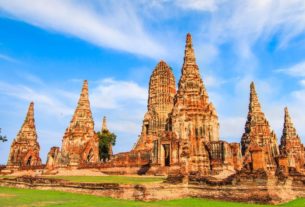
This is very good idea.
I love wood floor.
Thanks forsharing.